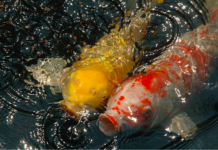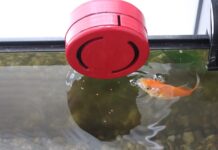Last Updated on February 10, 2024 by Fumipets
Dive into the Fascinating World of Freshwater Puffer Fish Breeds
Exploring the Unique Characteristics and Care Tips for Freshwater Puffer Fish
Freshwater Puffer Fish breeds are captivating aquatic creatures that have gained popularity among aquarium enthusiasts for their distinctive appearance and quirky behaviors.
These delightful fish, known for their ability to puff up when threatened, belong to the Tetraodontidae family, and various species can be found in freshwater habitats around the world. Whether you are a seasoned aquarium hobbyist or a beginner, the charm and charisma of freshwater puffer fish make them a captivating addition to any aquatic environment.
Now, let’s unravel the mysteries of these intriguing creatures through a series of questions and answers that cover everything from their habitat preferences to their unique behaviors.
Freshwater Puffer Fish Breeds
Raising freshwater pufferfish is a difficult task for even the most seasoned aquarium keeper. You’ll need a big tank and the capacity to filter the water rapidly and thoroughly, but we’ll assume you already know that and are here to compare a number of different species to discover which one you like.
We were able to gather 11 different freshwater pufferfish breeds to share with you so you can see if any of them grab your interest. We’ll show you what they look like as well as provide you with some information about each breed. Join us as we discuss size, filtration, color, tank length, and other factors to help you make an informed decision.
Here are the 11 different varieties of freshwater pufferfish we’ll go through with you.
The 11 puffer fish breed.
1. Congo Puffer
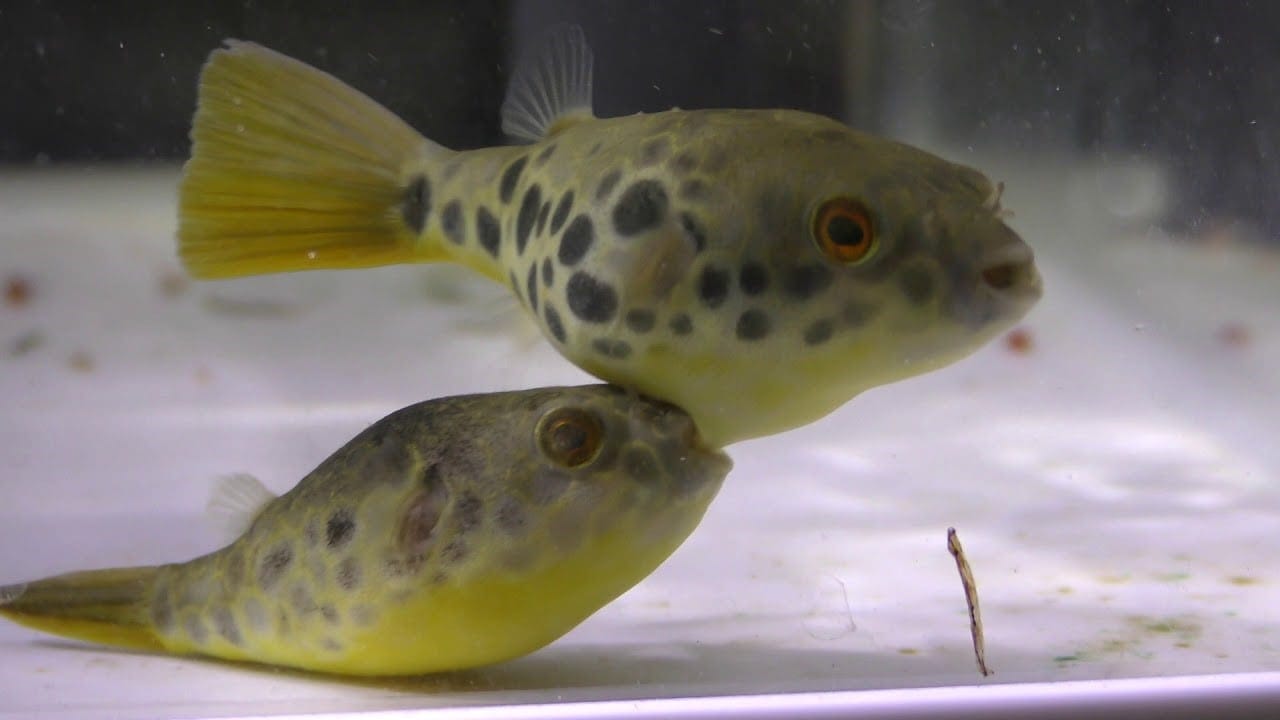
Congo pufferfish are found in African rivers, as its name suggests. They reach a length of around 6 inches and spend the most of their time buried in the sand at the bottom of your aquarium, away from predators. There are a variety of colors to choose from, like black, sand, and red, and the Congo will change their color to their surroundings, with the exception of blue. As with other pufferfish, they need a big tank and are particularly sensitive to nitrates, thus the water must be extensively filtered.
2. Dwarf Puffer

The Pea pufferfish and Pygmy pufferfish are other names for the dwarf pufferfish. It’s one of the world’s tiniest pufferfish, seldom growing more than an inch and a half in length. Due to overharvesting and habitat destruction, the Dwarf Puffer is presently listed as vulnerable by the International Union for Conservation of Nature. Because of its vivid colors and tiny stature, this breed is highly popular in aquariums. For a Dwarf, getting the correct size tank and filtration is considerably simpler than for many other breeds.
3. Fahaka Puffer
The Fahaka Puffer is one of the largest pufferfish species, reaching a maximum size of 16 inches when fully mature. Only experienced keepers should attempt to possess one of these breeds since they are exceedingly violent. You’ll need a tank that’s at least 60 inches long and has good filtration capabilities, as well as thick vegetation. While eating, these fish are known to lunge for your fingers and may inflict a nasty bite.
4. Golden Puffer

The Golden Puffer is available in two colors: light and dark. The pufferfish in the light form has a white body with yellow spots. A black body with yellow spots appears in the dark variant. Their bodies are rounded, and their little fins are positioned far back. Their skin has microscopic toothlike projections on it that look like sandpaper. These projections become more prominent as they puff up. There are some really enormous fish that may grow to be almost 20 inches long when completely mature.
5. Imitator Puffer
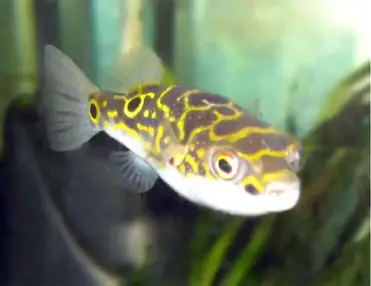
Another form of small pufferfish is the Imitator puffer, commonly known as the Dwarf Malabar Puffer. The color of this fish is brilliant yellow. Males have more vibrant colour than females, while females have black patches all over their body. Even though it’s a tiny fish, it’ll need a tank with at least 30 gallons of water.
6. MBU Puffer
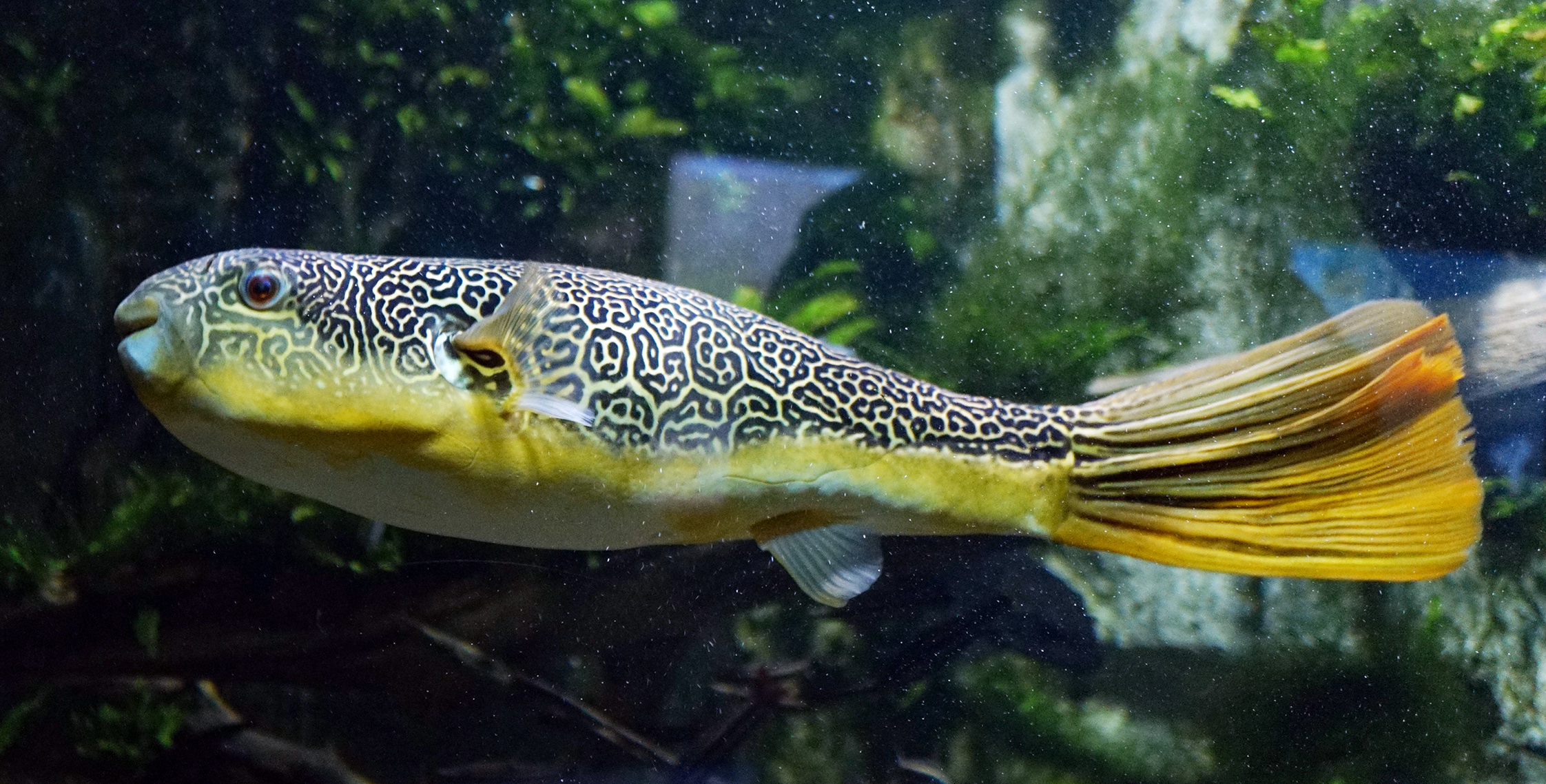
MBU Pufferfish are a huge pufferfish that may grow up to 26 inches in length. These fish are challenging to manage in an aquarium since they need a lot of room and filtration to be healthy. As a result, we only suggest this breed to seasoned pufferfish owners. MBU pufferfish have a distinctive body pattern that changes with age.
7. Ocellated Puffer

One of the rarest pufferfish breeds is the Ocellated pufferfish. This is a captivity-bred fish that currently lives in South Asian rivers and streams. The males of this species have distinct personalities, and they will aggressively defend any eggs. They like to be maintained in couples and are more tranquil than many other species. They may also be kept in a smaller tank than many others, requiring just approximately 20 gallons. You will, however, need a powerful filtering system.
8. Red-Eyed Puffer

The Red Eyed Puffer is a group of four pufferfish species that share the same red eye. This kind of pufferfish is considered to be more aggressive than others, as well as being more difficult to keep alive. Because these fish are more aggressive, they should be kept alone in an aquarium with no other pufferfish. Despite the fact that they seldom grow to be more than 2 inches long, they need a big tank since they create a lot of waste. An aquarium with a length of at least 32 inches is recommended. There will also be a need for a large number of live, tall plants.
9. Red-Tailed Dwarf Puffer

The Red-Tailed Dwarf pufferfish is a little breed that only reaches a maximum size of two inches. They like aquariums with abundance of living plants and somewhat acidic water. Males in this breed are notably bigger than females, and their bodies are dark brown with light cream-colored stripes on the bottom sides. Females are mottled brown in color and have uneven forms and patterns. Crimson eyes and red tail fins distinguish males and females.
10. South American Puffer

One of the few pufferfish that live in groups in the wild is the South American Puffer. It is, however, one of the most challenging fish to keep in an aquarium. Only experienced hobbyists should acquire this species, and even then, only if you have a very big tank that can accommodate multiples. They feature vivid golden and black stripes that stand out against the backdrop greenery when properly maintained.
A rectangular tank with a length of at least 47 inches is required for the South American Puffer. Water will need to be filtered thoroughly, and thick vegetation will need to be planted. You’ll also need to provide them with hard food since their teeth tend to overgrow, and you may need to manually cut them.
11. Target Puffer
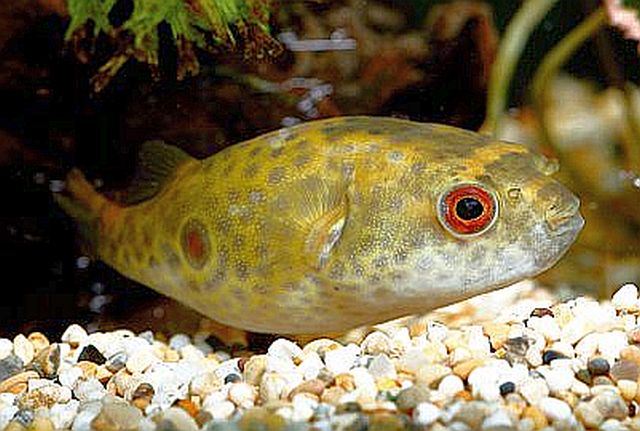
Target Pufferfish reach a maximum size of 6 inches and need a tank with a minimum length of 35 inches to live happily. Strong filtration is required all of the time, and the more water that circulates in the aquarium, the better. The pufferfish you’re after are nocturnal predators that are quite active at night. You may use a moonlight to help you keep track of your Target puffer quest.
Conclusion
If you can provide the right habitat for pufferfish to flourish, they may be highly rewarding. Many puffers grow to be very big, and even the tiny ones have personalities that are distinct from those of many other fish. It’s difficult to find a big enough tank and filter it properly, so it’s a commitment you’ll need to make ahead of time, especially since many of these fish live for more than five years.
If you’re new to pufferfish, we suggest one of the lesser varieties, such as the Dwarf Puffer, while a well grown MBU Puffer will make you the talk of the aquarium community. We hope you’ve liked our freshwater puffer fish guide and discovered a few puffers you’d like to keep.
Q&A: Exploring the World of Freshwater Puffer Fish Breeds
What makes freshwater puffer fish unique among aquarium species?
Freshwater puffer fish are distinctive for their ability to inflate themselves when threatened, turning into a round, spiky ball. This defensive mechanism is not only fascinating to witness but also serves as a means of deterring potential predators.
What are the common species of freshwater puffer fish found in aquariums?
Some popular species kept in aquariums include the Dwarf Puffer (Carinotetraodon travancoricus), Figure Eight Puffer (Tetraodon biocellatus), and Green Spotted Puffer (Tetraodon nigroviridis). Each species has its own unique characteristics and care requirements.
What is the ideal tank setup for freshwater puffer fish?
Freshwater puffer fish thrive in well-filtered tanks with plenty of hiding spots, plants, and smooth substrate. They prefer slightly brackish water conditions, so adding marine salt to mimic their natural habitat is beneficial. Keep in mind that puffer fish are territorial, so provide ample space and hiding spots to reduce aggression.
What is the preferred diet for freshwater puffer fish?
Puffer fish are carnivores with a keen appetite for live or frozen foods. Offer a varied diet that includes small snails, shrimp, bloodworms, and high-quality commercial puffer fish pellets. Chewing on snails also helps keep their continuously growing teeth in check.
How can I ensure the well-being of my freshwater puffer fish?
Regular water quality checks, maintaining proper filtration, and providing a balanced diet are essential for the health of freshwater puffer fish. Monitor their behavior for signs of stress or illness, and be mindful of their unique social dynamics to create a harmonious tank environment.



